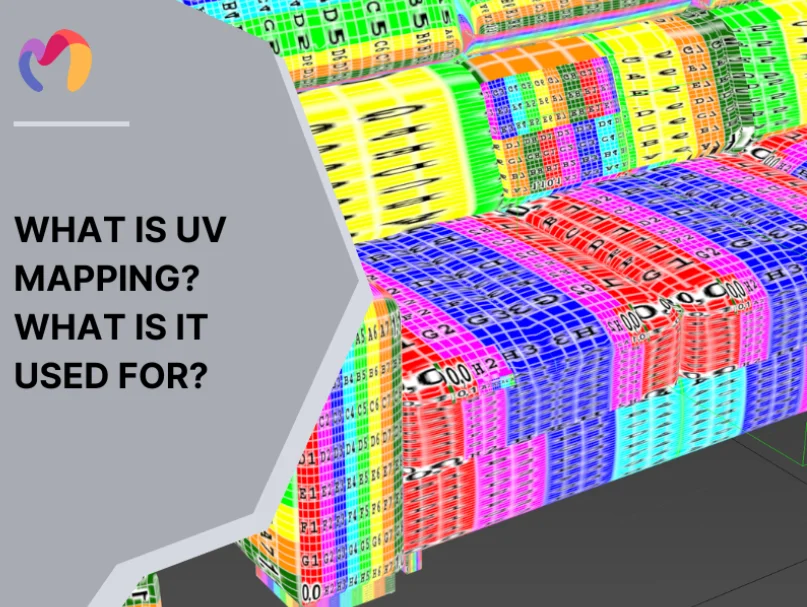UV mapping forms the foundation of texture application in 3D modeling across interior design, exterior design, and architectural visualization. This process transforms three-dimensional objects into two-dimensional planes where textures can be properly aligned and applied, similar to unwrapping a gift box to lay it flat. Professional 3D models require precise UV mapping to achieve photorealistic renders with accurate material properties, proper light interaction, and convincing surface details. The techniques used in UV mapping directly impact the final quality of architectural visualizations, furniture models, and design elements that clients and stakeholders evaluate.UV mapping forms texture application foundation in 3D design visualization.
What is UV mapping?
UV mapping assigns specific coordinates (U and V) to each vertex on a 3D model’s surface, creating a flat representation of the model similar to a sewing pattern. These coordinates establish precise locations where textures, materials, and surface details attach to the geometry, determining how digital “skins” wrap around objects.
The technique serves as the foundation for realistic material rendering in 3D visualization, allowing surfaces to display proper wood grain directions, tile patterns, fabric weaves, and reflective properties. Professional 3D designers rely on effective UV mapping to create convincing materials across architectural elements, furniture pieces, and decorative objects.
UV maps directly influence rendering quality in interior spaces, exterior building facades, and comprehensive architectural presentations where material authenticity impacts client decisions and project approvals.
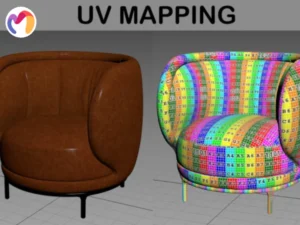
UV mapping assigns U and V coordinates to vertices, creating a flat model representation.
How UV mapping works?
UV mapping transforms complex 3D objects into flat 2D representations, similar to flattening a paper globe into a world map. 3D software creates this transformation by cutting along model edges and unfolding surfaces onto a square UV coordinate space. The process involves several key steps:
- UV unwrapping: Artists select strategic seam locations, using automatic tools for basic shapes or manual seams for complex objects
- Texture application: The flattened UV shells receive images and materials that map to specific areas of the 3D model
- Refinement: Designers adjust UV island positions and minimize distortion for optimal texture display
Precision in coordinate assignment prevents texture stretching across architectural surfaces. Designers manipulate island scale and placement to ensure material details like wood grain and fabric weaves align naturally. Well-executed UV maps enhance visual fidelity in client presentations.
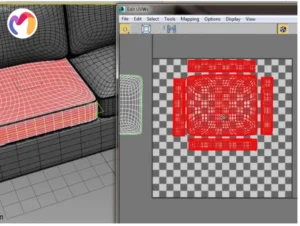 UV mapping transforms complex 3D objects into flat 2D representations.
UV mapping transforms complex 3D objects into flat 2D representations.
Types of UV map textures
Professional 3D artists select specific UV mapping techniques based on object geometry and project requirements. Different approaches offer varying control over texture placement and distortion management in architectural visualization.
- Automatic UV mapping: Software algorithms generate initial layouts quickly, ideal for background elements where perfect alignment isn’t critical
- Planar UV mapping: Projects textures from a single direction, perfect for flat surfaces like walls, floors, and ceiling panels
- Spherical UV mapping: Wraps textures around curved objects from a central point, reducing distortion on rounded shapes like lamps and vases
- User-defined UV mapping: Provides complete control through manual seam placement, essential for hero objects requiring precise alignment
For instance, when creating intricate lighting fixtures, using a chandelier 3d model free download can help you practice applying different UV mapping techniques to enhance realism. Professional visualizations often combine multiple mapping approaches within a single scene.
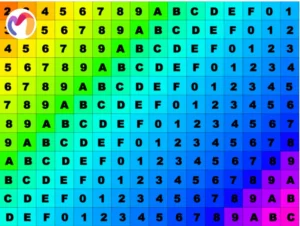 Professional 3D artists select UV mapping based on object geometry and project needs.
Professional 3D artists select UV mapping based on object geometry and project needs.
What can I do with UV mapping?
UV mapping opens creative possibilities for 3D artists working in architectural visualization and interior design fields. Properly executed UV coordinates enable texture layers to interact cohesively, creating sophisticated material representations that respond accurately to lighting conditions and viewing angles in rendering engines.
- Surface customization – Apply unique wear patterns, company logos, custom finishes, and site-specific details to standard architectural elements
- Material authenticity – Layer multiple texture maps (diffuse, normal, specular, displacement) on the same UV coordinates for physically accurate material behavior
- Render optimization – Reuse texture space efficiently to reduce file sizes while maintaining visual fidelity in complex scenes
If you’re working on outdoor scenes, experimenting with an exterior 3d model free download allows you to apply UV mapping principles for realistic building textures and landscaping. UV mapping skills directly impact project delivery timelines, with well-executed maps significantly reducing time spent on texture adjustments and material troubleshooting. Professional 3D artists consider proper UV mapping a fundamental technical requirement rather than an optional skill in contemporary visualization workflows.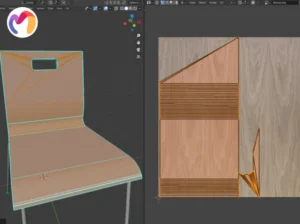 UV mapping opens creative possibilities for 3D artists in visualization fields.
UV mapping opens creative possibilities for 3D artists in visualization fields.
Conclusion
UV mapping forms the backbone of professional 3D visualization, directly influencing material quality and rendering realism in architectural and design projects. Artists who master UV techniques produce models with crisp textures, accurate material behavior, and consistent visual quality across different viewing distances. Practice with various mapping approaches builds technical proficiency while reducing production time on commercial projects. The effort invested in learning proper UV mapping pays dividends through faster workflows and more compelling visual presentations.
